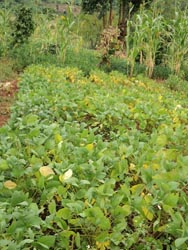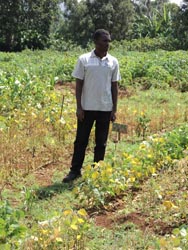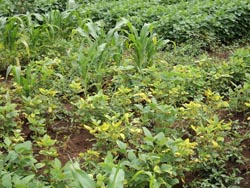Introduction
The Eastern part of DR Congo, in the Sud Kivu province, is one of the target areas of N2Africa. In DR Congo, N2Africa’s objectives 3 (rhizobiology studies) and 5 (capacity building) are led by Université Catholique de Bukavu (U.C.B.) through the faculty of agriculture, one of the project partners.
The team responsible for Rhizobiology activities at Kalambo (Objective 3) and Capacity building (Objective 5) in DRC, is led by Prof. Walangululu and consists of three trained core members to implement laboratory activities in the framework of objective 3 and one N2Africa core member to lead capacity building of farmers, while Prof. Walangululu leads the degree related training. Two of those three trained core members are engaged in MSc studies at University of Nairobi, Kenya.
Rhizobiology activities are not new in DRC; in the past, they were conducted at the National research center (INERA), Yangambi; one of the most prominent scientists well worldwide known is Bonnier, Belgian citizen, who left the country with the nationalization of the national research center. In the framework of the N2Africa project, rhizobiology activities are being carried out both in the soil analysis faculty laboratory of U.C.B. at Karhale and in the CIAT soil microbiology laboratory at Kalambo.
Activities carried out in 2011 were: collection of 10 soils samples and 39 rhizobium strains by a team of rhizobiologists of N2Africa, Nairobi, and sent to MIRCEN Nairobi, installation of 13 field trials in many locations (need to inoculate trials), collection from secured locations of North and South Kivu and isolation of 41 rhizobium strains characterized by DRC rhizobiology team in Bukavu; although planned, no MPNs and cultured isolates were initiated and no local inoculants produced; reference strains remained lacking. The causes for this shortcoming are complex, and responsibilities not easily assigned.
Activities planned in 2012 are bioprospection by collecting 213 rhizobium strains in 44 sites in Kalehe, Kabare, Walungu, Uvira and Idjwi locations, authentication and effectiveness of isolates collected strains, screening in greenhouse for BNF of collected isolates, conducting 50 MPNs in the greenhouse, 25 on soyabean and 25 on beans, quality control of reference commercial strains and production of inoculants for use in local trials.
Results
All 39 rhizobium strains collected by a team of rhizobiology of N2Africa Nairobi are now included in N2Africa Rhizobium database. Isolates were characterized and classified by Congo Red morphotype, BTB reaction and Gram Strain. Characteristics of rhizobium isolates collected by DRC rhizobiology team in Bukavu in 2011 are presented in Table 1. (For Tables 1 and 2 click here)
Yield of soyabean of need to inoculate trials are given in Table 2.
Widespread complex nutrient deficiency and toxicity symptoms were observed on soyabean, as shown in figures 1 to 3. After harvesting, a high variability of yield was noticed among treatments (CV>15 %). Yield of PK 06 was in general higher either on plants inoculated or not inoculated, except on plants fertilized with urea, reaching almost the potential of the variety at Murhesa location. Ibona and Burhinyi locations were seriously affected by drought. Results have been analyzed for publication.
 |
 |
 |
|
Fig.1: Deficiency and/or toxicity: Symptoms on soyabean at Kalehe |
Fig.2: Deficiency and/or toxicity: Symptoms on soyabean at Mushinga |
Fig.3: Deficiency and/or toxicity: Symptoms on soyabean at Kavumu |
Prof. Masamba Jean Walangululu
